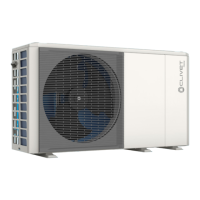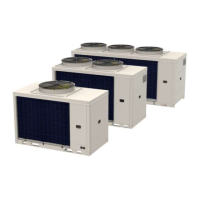10
About R-290 refrigerant
• if an electrical component is replaced, the new one must
be suitable for the intended use and in accordance with
the correct specifications
• follow the manufacturer's maintenance and service
instructions in all circumstances
• when in doubt, consult the manufacturer's technical
department
• the charge volume must be suitable for the room volume
and the intended use in which the components contai-
ning the refrigerant are installed, see the electrical instal-
lation requirements in EN 378
• ventilation devices and openings must open properly and
not be obstructed
• if an indirect refrigerant circuit is used, the presence of
refrigerant in the secondary circuits must be checked
• equipment markings must remain visible and legible
• markings and indications that become illegible must be
corrected
• pipes or other components of the refrigerant circuit must
be installed in locations where exposure to potentially
corrosive substances is unlikely for components contai-
ning the refrigerant, unless they are made of materials
inherently resistant to corrosion or adequately protected
against the risk of corrosion.
3.3.8 Checks on electrical devices
Remember that:
• the fixing and maintenance procedures for electrical
components must include initial safety checks and com-
ponent inspection procedures
• if a defect is found that may generate safety risks, the
power supply to the circuit must be interrupted until the
problem is satisfactorily resolved
• if the problem cannot be solved immediately, but it is
necessary to keep the system in operation, an appropria-
te temporary solution must be adopted
• the situation should be communicated to the owner of
the unit so that all persons concerned can be duly infor-
med
Carry out the following checks:
• check that the capacitors are discharged: this procedure
must be performed safely to avoid the possibility of
sparks
• check that there are no live components or wires exposed
while charging, resetting or venting the system
• check for ground fault interruptions
• check that the unit is not powered and if necessary
disconnect the power supply before proceeding with the
next steps
3.3.9 Fixing sealed components
Remember that:
• all electrical users must be disconnected from the equip-
ment before removing the seal covers, etc.
• if it is absolutely necessary to have a power supply during
the intervention, a permanent leak detection method
must be set up at the most critical point to signal any
potentially dangerous situations
• the use of silicone sealants may make some types of leak
detection equipment less effective.
Ensure that:
• the casing must not be altered to such an extent that the
required level of protection is compromised, including
damage to cables, excessive number of connections, use
of terminals that do not conform to the original specifica-
tions, damage to seals, incorrect assembly of glands, etc.
• the device must be installed safely.
• seals or sealing materials have not deteriorated to such
an extent that they no longer ensure a perfect seal kee-
ping flammable atmospheres from entering
• spare parts must comply with the manufacturer's specifi-
cations.
3.3.10 Fixing intrinsically safe components
Remember that:
• before applying capacitance or permanent inductance
loads to the circuit, check that this operation does not
result in the permissible voltage and current values for
the equipment in use being exceeded
• intrinsically safe components are the only types of
components that can be operated under voltage in the
presence of a flammable atmosphere
• the test device must have the correct nominal characteri-
stics
• only use parts specified by the manufacturer to replace
components
• other components can cause ignition of the refrigerant
released into the atmosphere.
3.3.11 Wiring
Check that:
• the wiring must not be exposed to wear, corrosion, exces-
sive pressure, vibration, sharp edges or other adverse
environmental influences.
The check should also take into account the eects of
ageing or continuous vibration from compressors, fans or
other similar sources.
3.3.12 Detection of flammable refrigerants
The use of potential ignition sources for the search or
detection of refrigerant leaks is prohibited under any
circumstances.
The use of halogen torches or other naked ame de-
tection systems is not permitted.

